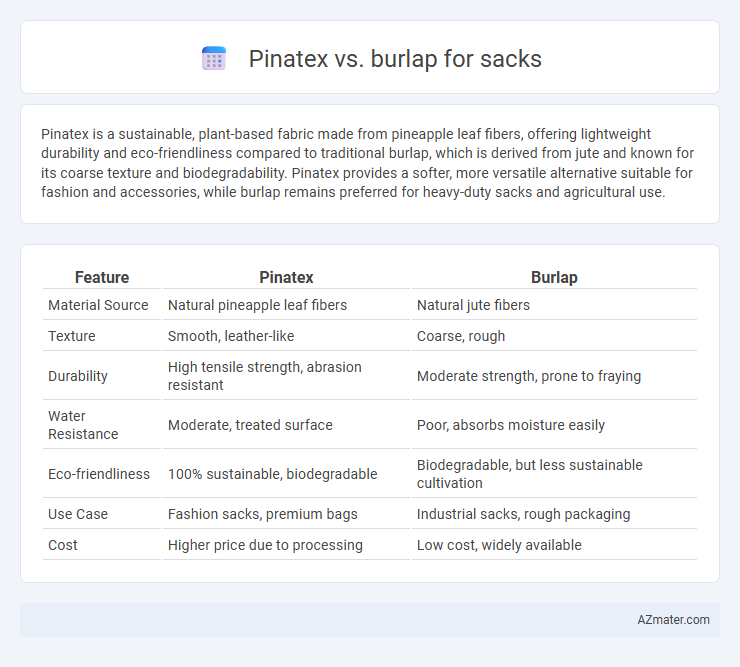Pinatex is a sustainable, plant-based fabric made from pineapple leaf fibers, offering lightweight durability and eco-friendliness compared to traditional burlap, which is derived from jute and known for its coarse texture and biodegradability. Pinatex provides a softer, more versatile alternative suitable for fashion and accessories, while burlap remains preferred for heavy-duty sacks and agricultural use.
Table of Comparison
| Feature | Pinatex | Burlap |
|---|---|---|
| Material Source | Natural pineapple leaf fibers | Natural jute fibers |
| Texture | Smooth, leather-like | Coarse, rough |
| Durability | High tensile strength, abrasion resistant | Moderate strength, prone to fraying |
| Water Resistance | Moderate, treated surface | Poor, absorbs moisture easily |
| Eco-friendliness | 100% sustainable, biodegradable | Biodegradable, but less sustainable cultivation |
| Use Case | Fashion sacks, premium bags | Industrial sacks, rough packaging |
| Cost | Higher price due to processing | Low cost, widely available |
Introduction to Piñatex and Burlap Sacks
Pinatex is an innovative, sustainable textile made from pineapple leaf fibers, offering a cruelty-free and eco-friendly alternative to traditional materials. Burlap sacks, crafted from jute fibers, are known for their durability, breathability, and natural biodegradability, commonly used in agriculture and storage. Both materials provide versatile packaging solutions, but Pinatex introduces a modern, plant-based option that appeals to environmentally conscious markets.
Material Origins: Piñatex vs Burlap
Pinatex is an innovative sustainable textile made from pineapple leaf fibers, repurposing agricultural waste to reduce environmental impact. Burlap, also known as hessian, originates from jute or hemp plant fibers, traditionally cultivated in South Asia and valued for its durability and breathability. The material origins highlight Pinatex's eco-friendly approach by utilizing fruit waste, while burlap emphasizes natural plant-based fibers with a long history in sack production.
Production Process Comparison
Pinatex production involves extracting fibers from pineapple leaves, followed by a non-woven felt process using environmentally friendly binding agents, resulting in a sustainable, leather-like material with minimal waste. Burlap is produced by weaving jute fibers harvested from the jute plant, requiring water-intensive retting and mechanical processing, which can contribute to environmental degradation. Pinatex's innovative use of agricultural waste and lower water usage offers a more eco-friendly alternative to the traditional, resource-heavy burlap sack production.
Durability and Strength Analysis
Pinatex, made from pineapple leaf fibers, offers high tensile strength and excellent durability, resisting wear and tear better than traditional burlap sacks. Burlap, derived from jute fibers, is breathable but less resistant to abrasion and environmental degradation, making it prone to fraying and weakening over time. Pinatex's combination of natural fiber reinforcement and innovative processing results in a longer-lasting, eco-friendly alternative for heavy-duty sack applications.
Environmental Impact and Sustainability
Pinatex, made from pineapple leaf fibers, offers a sustainable alternative to burlap by utilizing agricultural waste, reducing landfill waste and chemical processing compared to traditional burlap, which is derived from jute plants requiring extensive water use and pesticide application. The production of Pinatex consumes less water and energy, lowering its carbon footprint significantly, while burlap's biodegradable nature is offset by its environmental cost and slower decomposition in some conditions. Both materials promote eco-friendly packaging, but Pinatex stands out for its innovative use of renewable resources and minimal environmental impact throughout the lifecycle of the sack.
Cost Comparison: Piñatex vs Burlap Sacks
Pinatex sacks typically cost more than traditional burlap sacks due to their innovative use of pineapple leaf fibers and sustainable production methods, appealing to eco-conscious markets. Burlap sacks, made from jute, remain more affordable and widely available, making them a cost-effective choice for bulk storage and packaging. Despite the higher price, Pinatex offers durability and environmental benefits that may justify the investment for premium or green-focused products.
Aesthetic and Texture Differences
Pinatex features a smooth, leather-like texture derived from pineapple leaf fibers, offering a sleek and modern aesthetic with subtle natural grain patterns. Burlap, made from jute fibers, presents a coarse, rough texture that emphasizes a rustic, earthy look with visible woven strands and irregularities. The contrasting tactile experiences make Pinatex ideal for stylish, contemporary sack designs, while burlap suits traditional, rugged applications.
Versatility and Practical Applications
Pinatex offers superior versatility compared to burlap, being lightweight, flexible, and durable, which makes it ideal for fashion accessories, upholstery, and eco-friendly packaging. Burlap, while sturdy and breathable, is primarily used for agricultural sacks, storage, and rustic decor but lacks adaptability in modern design applications. Pinatex's water-resistant and biodegradable properties expand its practical uses beyond traditional burlap sacks, supporting sustainable and innovative product development.
Biodegradability and End-of-Life Considerations
Pinatex, derived from pineapple leaf fibers, offers superior biodegradability compared to traditional burlap, decomposing naturally within months under composting conditions. Burlap, made from jute, biodegrades slower due to its coarse texture and potential chemical treatments, affecting its environmental impact. End-of-life considerations favor Pinatex for sustainable disposal and reduced landfill persistence, while burlap may require enhanced processing to minimize ecological footprint.
Summary: Which Sack Material is Better?
Pinatex offers a sustainable and eco-friendly alternative to burlap sacks, made from pineapple leaf fibers that provide durability, flexibility, and water resistance. Burlap, traditionally made from jute, is strong and biodegradable but tends to be rough, less water-resistant, and prone to mold in damp conditions. For sacks requiring enhanced durability and environmental benefits, Pinatex is generally the superior choice, while burlap remains a cost-effective option for traditional uses.

Infographic: Piñatex vs Burlap for Sack
 azmater.com
azmater.com